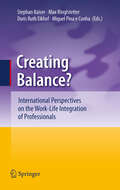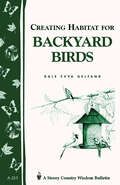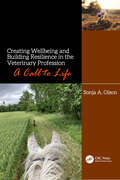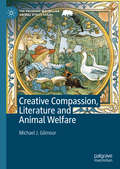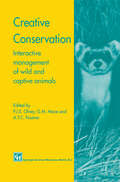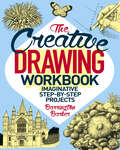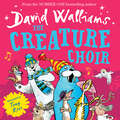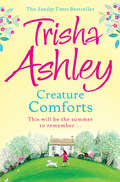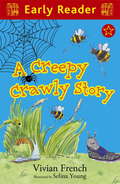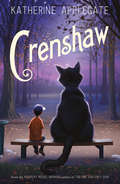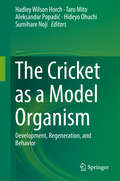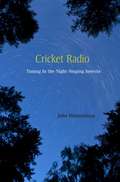- Table View
- List View
Creating Africas: Struggles Over Nature, Conservation and Land
by Knut NustadIn Africa, conflicts between protected areas for fauna and flora and space for their surrounding human populations continue despite years spent trying to find an accommodation between the needs of both parties. Creating Africas investigates the roots of the current conservation boom, demonstrates that it is part of a struggle over various definitions of existing realities, and examines the global effects of this struggle. The book discusses the first UNESCO World Heritage Site in South Africa, the Isimangaliso (St Lucia) Wetland Park. Here, conservation interests are pitted against those of industrial forestry, commercial farming, and local communities struggling to have their lands returned to them. They all seek to define and create their own realities, but do so with very different resources at their disposal. In his expert analysis, Nustad treats these realities not as different representations but rather as multiple, often competing, viewpoints that involve a wide range of actors, both human and non-human. Nustad posits that in order to avoid being accused of neo-colonial land grabbing, the conservation lobby will need to find a new way of imagining nature and protection that includes people.
Creating Africas: Struggles Over Nature, Conservation and Land
by Knut NustadIn Africa, conflicts between protected areas for fauna and flora and space for their surrounding human populations continue despite years spent trying to find an accommodation between the needs of both parties. Creating Africas investigates the roots of the current conservation boom, demonstrates that it is part of a struggle over various definitions of existing realities, and examines the global effects of this struggle. The book discusses the first UNESCO World Heritage Site in South Africa, the Isimangaliso (St Lucia) Wetland Park. Here, conservation interests are pitted against those of industrial forestry, commercial farming, and local communities struggling to have their lands returned to them. They all seek to define and create their own realities, but do so with very different resources at their disposal. In his expert analysis, Nustad treats these realities not as different representations but rather as multiple, often competing, viewpoints that involve a wide range of actors, both human and non-human. Nustad posits that in order to avoid being accused of neo-colonial land grabbing, the conservation lobby will need to find a new way of imagining nature and protection that includes people.
Creating Balance?: International Perspectives on the Work-Life Integration of Professionals
by Stephan Kaiser, Max Josef Ringlstetter, Doris Ruth Eikhof and Miguel Pina e CunhaA satisfactory and healthy integration of work with other life domains is one of the key challenges of modern society. Work-life balance and work-life integration have become focal points of today’s human resource management practice and theory. Professionals who have been described as “extreme workers” regarding their work hours and engagement are under particular pressure to balance work and ”the rest of life”.This collection maps the increasingly extensive discussion of work-life issues for professionals and discusses key aspects in depth. What is work-life integration? What are the specific challenges for professionals? How do they manage their blurred work-life boundaries? How can companies intervene? Internationally leading authors discuss antecedents and individual and organizational outcomes of work-life integration, gender-specific perspectives and challenges as well as the use and usefulness of corporate work-life balance initiatives. In five sections distinguished researchers from across the world present experiences and research findings to provide a compendium of academic and applied research on the work-life integration of professionals. Cutting-edge research and novel theoretical perspectives make this collection a source of knowledge and inspiration for academic and business audiences interested in work-life integration issues in general and in the case of professionals in particular.
Creating Habitat for Backyard Birds: Storey's Country Wisdom Bulletin A-215 (Storey Country Wisdom Bulletin)
by Dale Evva GelfandSince 1973, Storey's Country Wisdom Bulletins have offered practical, hands-on instructions designed to help readers master dozens of country living skills quickly and easily. There are now more than 170 titles in this series, and their remarkable popularity reflects the common desire of country and city dwellers alike to cultivate personal independence in everyday life.
Creating Wellbeing and Building Resilience in the Veterinary Profession: A Call to Life
by Sonja A. OlsonA Call to Life aims to help veterinary caregivers increase self-efficacy, decrease unnecessary suffering, and increase sustainability in their mission to support animal health around the world. The veterinary profession is powered by dedicated, bright, and selfless individuals. Unfortunately, the long-standing and dysfunctional culture in classrooms and practices around the world expects veterinary caregivers to be ready to sacrifice everything – their time, their health, their personal lives – in the name of being deemed qualified and ‘worthy.’ Integrating real-life stories from a range of veterinary caregivers with evidence-based theory, practical activities, discussion and reflection points, and insights drawn from the author’s own experiences, the book empowers veterinarians by showing that they have the ability and the control to choose a healthier way forward for themselves and for their profession. It describes how to: Normalize the conversation around mental and emotional health challenges in caregiving environments Discuss and collaboratively create systemic solutions that promote healthier ‘ecosystems’ for vets to work within Develop the skills of reframing, mindfulness, and self-care strategy implementation supporting holistic veterinary well-being Collectively choose to shift the framework of professional conversations towards psychological safety, optimism, and purpose-driven experiences. Creating Wellbeing and Building Resilience in the Veterinary Profession: A Call to Life uniquely combines shared experiences (personal stories) with academic research into the contributing factors of compassion fatigue and how to counter these. Normalizing the conversation in the profession, it provides a wide array of possible solutions to build resilience and to shape a culture of collaboration and support where caregivers can flourish.
Creating Wellbeing and Building Resilience in the Veterinary Profession: A Call to Life
by Sonja A. OlsonA Call to Life aims to help veterinary caregivers increase self-efficacy, decrease unnecessary suffering, and increase sustainability in their mission to support animal health around the world. The veterinary profession is powered by dedicated, bright, and selfless individuals. Unfortunately, the long-standing and dysfunctional culture in classrooms and practices around the world expects veterinary caregivers to be ready to sacrifice everything – their time, their health, their personal lives – in the name of being deemed qualified and ‘worthy.’ Integrating real-life stories from a range of veterinary caregivers with evidence-based theory, practical activities, discussion and reflection points, and insights drawn from the author’s own experiences, the book empowers veterinarians by showing that they have the ability and the control to choose a healthier way forward for themselves and for their profession. It describes how to: Normalize the conversation around mental and emotional health challenges in caregiving environments Discuss and collaboratively create systemic solutions that promote healthier ‘ecosystems’ for vets to work within Develop the skills of reframing, mindfulness, and self-care strategy implementation supporting holistic veterinary well-being Collectively choose to shift the framework of professional conversations towards psychological safety, optimism, and purpose-driven experiences. Creating Wellbeing and Building Resilience in the Veterinary Profession: A Call to Life uniquely combines shared experiences (personal stories) with academic research into the contributing factors of compassion fatigue and how to counter these. Normalizing the conversation in the profession, it provides a wide array of possible solutions to build resilience and to shape a culture of collaboration and support where caregivers can flourish.
The Creative Animal: How Every Animal Builds its Own Existence
by Roberto MarchesiniThis book deals with the theme of creativity in the animal world, conceived as a basic function for adapting to specific situations and as a source of innovations and inventions. Creativity is a fundamental resource for the individual who always has a leading role in conduct. To explain creativity, the book focuses on the concept of animal subjectivity, providing a new explanatory model of behavior capable of overcoming the image of the animal moved by automatisms. This model does not use consciousness as a necessary condition, but is based: 1) on affective components, such as behavioral motives, and 2) cognitive, as tools used by the subject to carry out his purposes. Particular attention is paid to the learning processes showing the subjective character of the experience. One topic addressed is the role of creativity in the evolution of living beings: how an invention, by modifying the niche characteristics, is able to change the selective pressures and the trajectory of phylogeny. Roberto Marchesini explains that creativity is a factor that is anything but rare or exceptional in the animal world—it constitutes a fundamental quality for many aspects of animal life.
Creative Compassion, Literature and Animal Welfare (The Palgrave Macmillan Animal Ethics Series)
by Michael J. GilmourThis book examines animal welfare themes in fiction, and considers how authors of the last two centuries undermine dominative attitudes toward the nonhuman. Appearing alongside the emerging humane movements of the nineteenth century and beyond is a kind of storytelling sympathetic to protectionist efforts well-described as a literature of protest. Compassion-inclined tales like the Dolittle adventures by Hugh Lofting educate readers on a wide range of ethical questions, empathize with the vulnerable, and envision peaceful coexistence with other species. Memorable characters like Black Beauty and Beautiful Joe, Ivan the gorilla and Louis the trumpeter swan, Hazel and Cheeta, Mr. Bultitude and Doctor Rat do not merely amuse. They are voices from the margins who speak with moral urgency to those with ears to hear. This broad survey of ethical themes in animal fiction highlights the unique contributions creative writers make toward animal welfare efforts.
Creative Conservation: Interactive management of wild and captive animals
by A. T. C.Feistner G. M. Mace P. J. S.OlneyPast progress and future challenges R.J. Wheater Royal Zoological Society of Scotland, Edinburgh, UK. In the past two decades much has been achieved in the sphere of breeding endangered species, and we should be pleased that our co operative efforts have already borne so much fruit. However, on balance and despite the best efforts of conservationists, the position of wildlife in the wild places where they are best conserved has become worse, often dramatically worse. Before returning to the United Kingdom in 1972, I was in Uganda for 16 years, most of which time was spent as Chief Warden of Murchison Falls National Park. Our main problem was that an over-population of large mammals was having a devastating impact on the habitat. Devas tation was being wrought on woodland areas by the arrival of large numbers of elephants into the sanctuary of the Park, following changes in land use in the areas outside the Park. These changes were in response to the requirements of an ever-expanding human population.
The Creative Drawing Workbook: Imaginative Step-by-Step Projects
by Barrington BarberThis inspiring drawing manual will help you to build your skills and develop your creativity, whatever your level of experience. Bestselling art instruction author Barrington Barber shows how to find subjects that interest you and develop them into attractive artworks that you and others can enjoy.You will discover how to create geometric compositions and patterns, explore the natural world as a source of inspiration, and see how everyday subjects can be transformed into decorative, original drawings. Throughout the book, you are encouraged to enjoy the process of drawing as well as the final result, with clear examples guiding you every step of the way.
Creative Governance: Opportunities for Fisheries in Europe (Routledge Revivals)
by Jan Kooiman, Martijn Van Vliet and Svein JentoftPublished in 1999, Creative Governance sets out to develop new ideas on the development of Fisheries in Europe. The scholarly and political attention for fisheries in general within Europe is predominantly focused on problems of controlling catch. In this book it is not the problems of harvesting which are taken as the starting point, but opportunities in fisheries as a whole: catch, processing, market and consumption of fish and fish products. The discussion is broadened to include the management of fisheries from the perspective of governance rather than management or policy. Governance is a new and important concept currently being developed in several areas of social science, in this book the governance concept is related to the creation of new opportunities of fisheries in Europe. The combination of these two approaches is not only important for fisheries (in Europe) but also to the governance of natural resources more generally where the shift from a problem to an opportunity and from a management or a governance approach might shed new light and stimulate new actions. The book is the product of close cooperation between scholars from biological, geographical, political science, management studies and anthropological backgrounds.
Creative Governance: Opportunities for Fisheries in Europe (Routledge Revivals)
by Jan Kooiman Martijn Van Vliet Svein JentoftPublished in 1999, Creative Governance sets out to develop new ideas on the development of Fisheries in Europe. The scholarly and political attention for fisheries in general within Europe is predominantly focused on problems of controlling catch. In this book it is not the problems of harvesting which are taken as the starting point, but opportunities in fisheries as a whole: catch, processing, market and consumption of fish and fish products. The discussion is broadened to include the management of fisheries from the perspective of governance rather than management or policy. Governance is a new and important concept currently being developed in several areas of social science, in this book the governance concept is related to the creation of new opportunities of fisheries in Europe. The combination of these two approaches is not only important for fisheries (in Europe) but also to the governance of natural resources more generally where the shift from a problem to an opportunity and from a management or a governance approach might shed new light and stimulate new actions. The book is the product of close cooperation between scholars from biological, geographical, political science, management studies and anthropological backgrounds.
The Creature Choir
by David WalliamsSing your heart out this Christmas with a whole choir of characters, in the showstopping new picture book from number one bestselling author David Walliams, illustrated by the artistic genius, Tony Ross!
Creature Comforts
by Trisha AshleyFrom the No.1 bestselling author of The Christmas Invitation This will be the summer to remember…
Creatures of Empire: How Domestic Animals Transformed Early America
by Virginia DeJohn AndersonWhen we think of the key figures of early American history, we think of explorers, or pilgrims, or Native Americans--not cattle, or goats, or swine. But as Virginia DeJohn Anderson reveals in this brilliantly original account of colonists in New England and the Chesapeake region, livestock played a vitally important role in the settling of the New World. Livestock, Anderson writes, were a central factor in the cultural clash between colonists and Indians as well as a driving force in the expansion west. By bringing livestock across the Atlantic, colonists believed that they provided the means to realize America's potential. It was thought that if the Native Americans learned to keep livestock as well, they would be that much closer to assimilating the colonists' culture, especially their Christian faith. But colonists failed to anticipate the problems that would arise as Indians began encountering free-ranging livestock at almost every turn, often trespassing in their cornfields. Moreover, when growing populations and an expansive style of husbandry required far more space than they had expected, colonists could see no alternative but to appropriate Indian land. This created tensions that reached the boiling point with King Philip's War and Bacon's Rebellion. And it established a pattern that would repeat time and again over the next two centuries. A stunning account that presents our history in a truly new light, Creatures of Empire restores a vital element of our past, illuminating one of the great forces of colonization and the expansion westward.
Creatures of Empire: How Domestic Animals Transformed Early America
by Virginia DeJohn AndersonWhen we think of the key figures of early American history, we think of explorers, or pilgrims, or Native Americans--not cattle, or goats, or swine. But as Virginia DeJohn Anderson reveals in this brilliantly original account of colonists in New England and the Chesapeake region, livestock played a vitally important role in the settling of the New World. Livestock, Anderson writes, were a central factor in the cultural clash between colonists and Indians as well as a driving force in the expansion west. By bringing livestock across the Atlantic, colonists believed that they provided the means to realize America's potential. It was thought that if the Native Americans learned to keep livestock as well, they would be that much closer to assimilating the colonists' culture, especially their Christian faith. But colonists failed to anticipate the problems that would arise as Indians began encountering free-ranging livestock at almost every turn, often trespassing in their cornfields. Moreover, when growing populations and an expansive style of husbandry required far more space than they had expected, colonists could see no alternative but to appropriate Indian land. This created tensions that reached the boiling point with King Philip's War and Bacon's Rebellion. And it established a pattern that would repeat time and again over the next two centuries. A stunning account that presents our history in a truly new light, Creatures of Empire restores a vital element of our past, illuminating one of the great forces of colonization and the expansion westward.
Creatures Of Habitat: The Changing Nature of Wildlife and Wild Places in Utah and the Intermountain West
by Mark HengesbaughFrom flying squirrels on high wooded plateaus to hanging gardens in redrock canyons, the Intermountain West is home to some of the world's rarest and most fascinating animals and plants. Creatures of Habitat details many unique but little-known talents of this region's strange and wonderful wild inhabitants and descibes their connections with native environments. For example, readers will learn about the pronghorn antelope's supercharged cardiovascular system, a brine shrimp-powered shorebird that each year flies nonstop from the Great Salt Lake to Central Argentina, and a rare mustard plant recently discovered on Mount Ogden. Emphasizing how increasing loss and degradation of habitat hinders native species' survival, Mark Gerard Hengesbaugh discusses what is happening to wildlife and wild places and what is being done about it. Well illustrated, this book has habitat maps, pen-and-ink illustrations, and fifty photos of wildlife and wild places selected by photo editor Dan Miller. Also included are guides to wildlife viewing and lists of Utah species, including those considered sensitive, threatened, or endangered.
Creatures of Jurisprudence: Bears and Bees as Juridical Species
by Edward MussawirTo what extent can an animal constitute a ‘juridical species’? This highly original book considers how animals have been integral to law and to legal thinking.Going beyond the traditional approaches to animal rights and the question of whether non-human animals may be considered legal ‘subjects,’ this book follows two types of animal – bears and bees – and asks what existence these species have maintained in juridical thought. Uncovering surprising roles that the animals play in the imagination of and solution to jurisprudential problems, the book offers a counter-argument to the view that juridical thought reduces one’s appreciation for the singularity and independence of their lives. It shows, rather, that the animals exert a remarkable influence on the creative dimensions of law, offering a liveliness to it that is worthy of close attention.Contributing to new directions at the intersection of jurisprudence and human–animal studies, this book will appeal to those with interests in either of these areas.
Creatures of Jurisprudence: Bears and Bees as Juridical Species
by Edward MussawirTo what extent can an animal constitute a ‘juridical species’? This highly original book considers how animals have been integral to law and to legal thinking.Going beyond the traditional approaches to animal rights and the question of whether non-human animals may be considered legal ‘subjects,’ this book follows two types of animal – bears and bees – and asks what existence these species have maintained in juridical thought. Uncovering surprising roles that the animals play in the imagination of and solution to jurisprudential problems, the book offers a counter-argument to the view that juridical thought reduces one’s appreciation for the singularity and independence of their lives. It shows, rather, that the animals exert a remarkable influence on the creative dimensions of law, offering a liveliness to it that is worthy of close attention.Contributing to new directions at the intersection of jurisprudence and human–animal studies, this book will appeal to those with interests in either of these areas.
Creatures of the Dark
by L. Alterman Gerald A. Doyle M. K. IzardThe papers in this volume are representative of those presented at a conference entitled "Creatures of the Dark: The Nocturnal Prosimians," held at Duke University, June 9-12, 1993. The purpose of the conference, attended by more than 100 scientists, was to assemble, for the ftrst time ever, scholars from diverse ftelds with a common interest in the nocturnal prosimian primates. The history of the precursors of this meeting are outlined in the Historical Perspective by Doyle (this volume). Most of the invited papers are presented here in modified form, as are several papers originally presented as posters. Two papers are included that were not presented, due to scheduling conftcts and health considerations. Some papers, delivered from the podium, are not included in this volume. Interactions among conference participants resulted in many revisions to the contributions, as did the comments of reviewers and the editors. Several papers which contained new data or new interpretations of familiar phenomena met with constructive criticism, resulting in modification of the original papers. We thank all of the contributors for their patience and cooperation, and commend the numerous reviewers who generously donated their time and expertise. We greatly appreciate funding from the National Institutes of Health, the Wenner Gren Foundation for Anthropological Research, the Duke University Center for International Studies, the Duke University Primate Center, and Drs. Charles Putman of Duke University and Malcolm Gillis, currently of Rice Universtiy.
A Creepy Crawly Story (Early Reader)
by Vivian FrenchEarly Readers are stepping stones from picture books to reading books. A blue Early Reader is perfect for sharing and reading together. A red Early Reader is the next step on your reading journey.When naughty Wizz Bee and Buzz Bee come home without any honey, Queen Bee is very cross. Can they cheer her up with a story?
Crenshaw
by Katherine ApplegateThe heart-warming new story about family and friendships from Newbery Medal-winner Katherine Applegate.
The Cricket as a Model Organism: Development, Regeneration, and Behavior
by Hadley Wilson Horch Taro Mito Aleksandar Popadić Hideyo Ohuchi Sumihare NojiThis book covers a broad range of topics about the cricket from its development, regeneration, physiology, nervous system, and behavior with remarkable recent updates by adapting the new, sophisticated molecular techniques including RNAi and other genome editing methods. It also provides detailed protocols on an array of topics and for basic experiments on the cricket.While the cricket has been one of the best models for neuroethological studies over the past 60 years, it has now become the most important system for studying basal hemimetabolous insects. The studies of Gryllus and related species of cricket will yield insight into evolutionary features that are not evident in other insect model systems, which mainly focus on holometabolous insects such as Drosophila, Tribolium, and Bombyx. Research on crickets and grasshoppers will be important for the development of pest-control strategies, given that some of the most notorious pests also belong to the order Orthoptera. At the same time, crickets possess an enormously high “food conversion efficiency”, making them a potentially important food source for an ever-expanding human population.This volume provides a comprehensive source of information as well as potential new applications in pest management and food production of the cricket. It will inspire scientists in various disciplines to use the cricket model system to investigate interesting and innovative questions.
Cricket (Large Print)
This is a picture of a cricket viewed from the top and facing towards the top of the page. There is a locator dot shown, which will be at the top left of the page when the image is the right way up. Just down the page, there is a silhouette of the cricket at approximately real size. At the top centre of the page are its feelers shown leading down to its head, with two eyes showing. Down the page, the cricket's thorax is shown, with three segmented legs, covered in small hairs, on either side. Further down the page is the abdomen and at the very bottom of the page are its reproductive organs extending downwards from the abdomen.
Cricket Radio: Tuning in the Night-Singing Insects
by John HimmelmanAt a time when night-singing insects have slipped beyond our notice—indeed, are more likely to be heard as NatureSounds than in a backyard—John Himmelman seeks to reconnect us to creatures whose songs form a part of our own natural history. On warm summer evenings, night-singing insects produce a whirring, chirping soundscape—a calming aural tapestry celebrated by poets and naturalists for millennia. But “cricket radio” is not broadcast for the easy-listening pleasure of humans. The nocturnal songs of insects are lures and warnings, full of risks and rewards for these tiny competitive performers. What moves crickets and katydids to sing, how they produce their distinctive sounds, how they hear the songs of others, and how they vary cadence, volume, and pitch to attract potential mates, warn off competitors, and evade predators is part of the engaging story Cricket Radio tells. Himmelman’s narrative weaves together his personal experiences as an amateur naturalist in search of crickets and katydids with the stories of scientists who study these insects professionally. He also offers instructions for bringing a few of the little singers into our homes and gardens. We can, Himmelman suggests, be reawakened to these night songs that have meant so much to the human psyche. The online insect calls that accompany this colorfully illustrated narrative provide a bridge of sound to our past and to our vital connection with other species.

